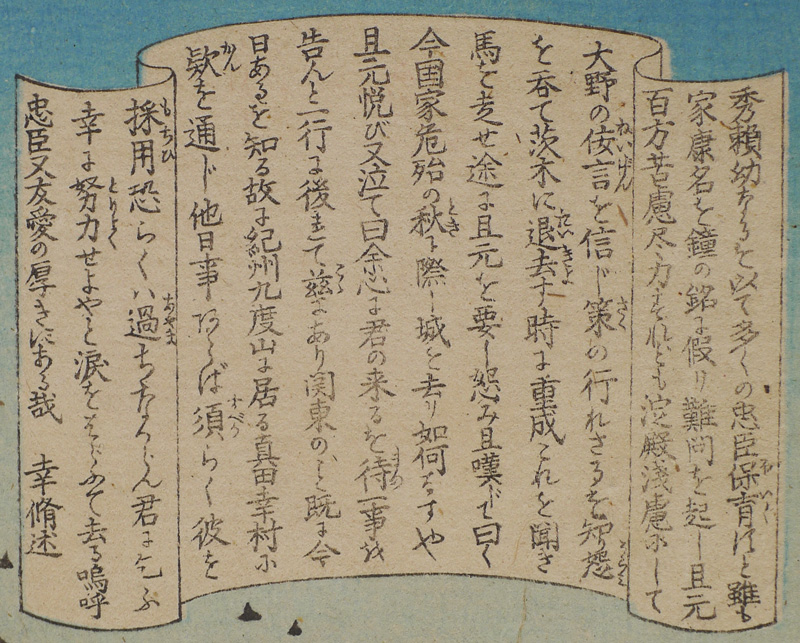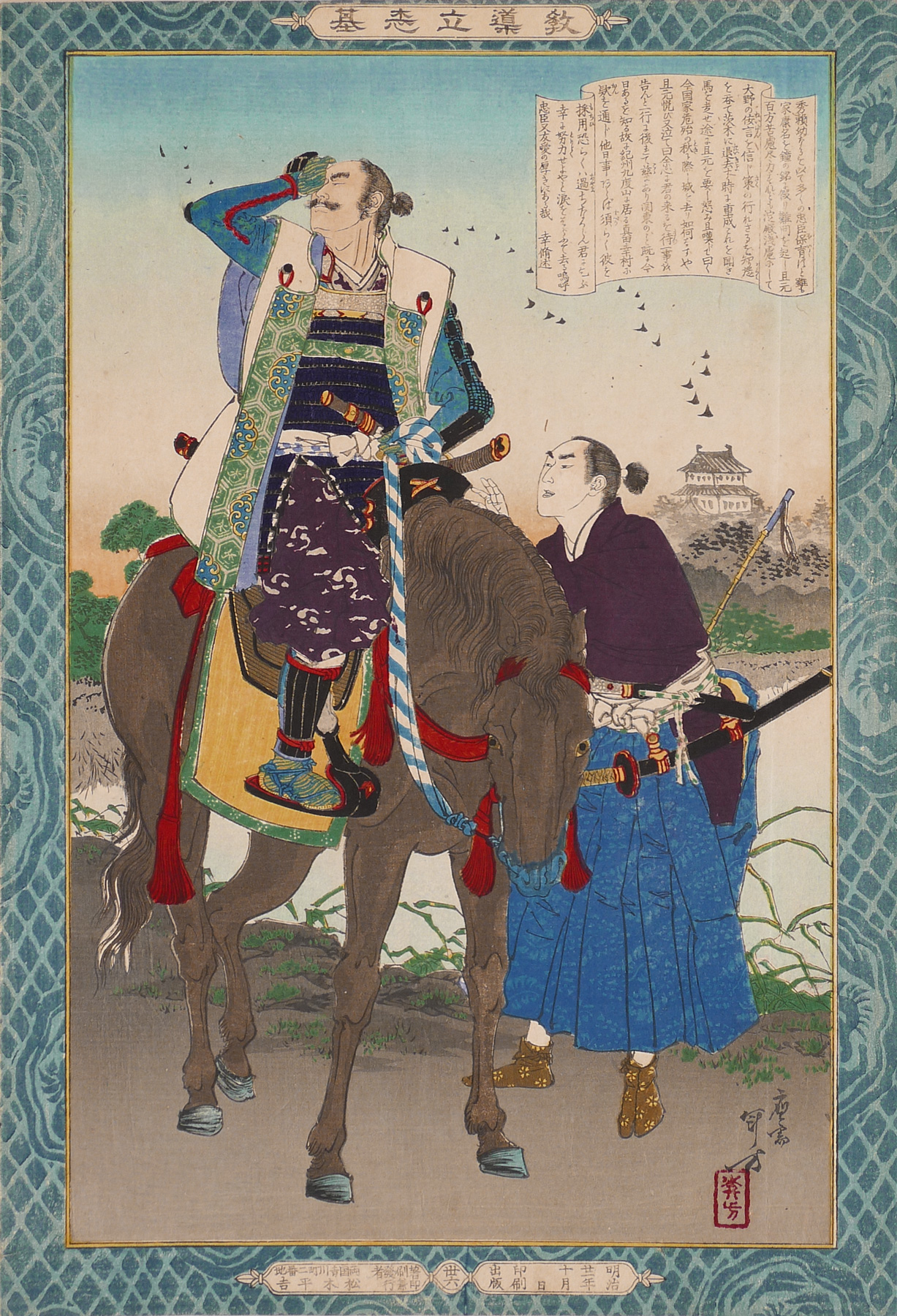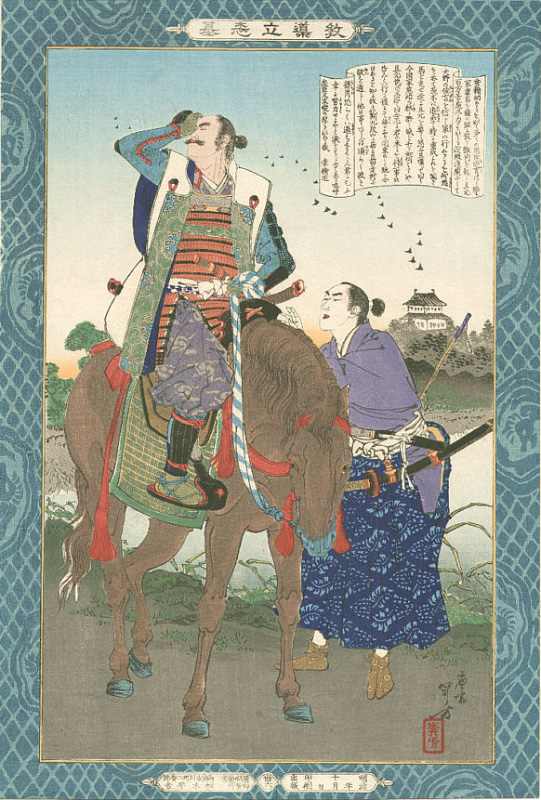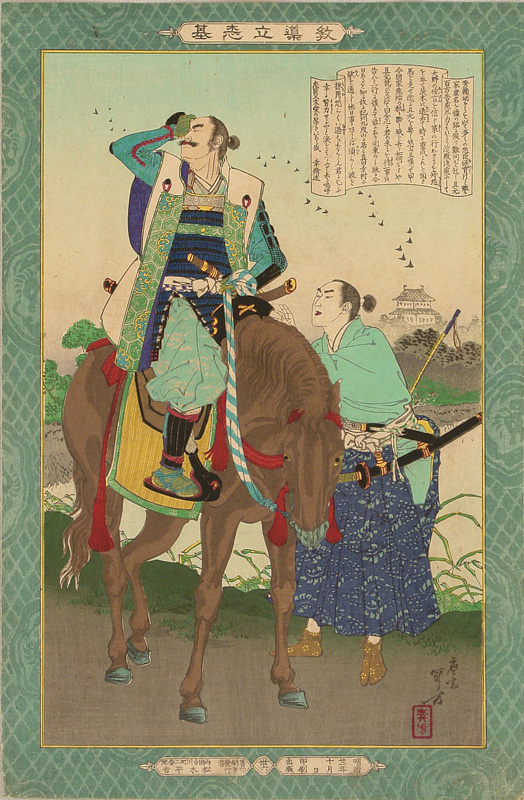About This Print
Source: Portland, Oregon based art historian Lynn Katsumoto in an email dated 05/31/2014.
Two states of this print are in the collection and at least three other states of this print are known (see below), speaking to its, and the entire print series', popularity and frequent reissues. IHL Cat. #1033 caries the print number 卅六 (36)2 in the center of the publisher's cartouche at the bottom of the print, along with an issue date of October 1888 明治廿一年十月. IHL Cat. #1034 carries neither a print number nor a date. It is likely a later issue than the dated print.
The artist Mizuno Toshikata contributed 16 prints to this series.
2 Numbering of the prints was haphazard during the production of the series. Print numbers were sometimes inadvertently omitted; some prints in the series were never assigned numbers and a few of the same numbers appear on different prints.

A comparison between the two states of this print in this collection
Transcription of Scroll
A scroll, present on each print in the series, contains brief historical details of the figure and scene being portrayed.

click on image to enlarge
Source: with thanks to Yajifun http://yajifun.tumblr.com/
36 Katagiri Katsumoto, Kimura Shigenari 且元と重成
教導立志基 卅六 片桐正一(片桐且元と木村重成) 水野年方 1888年10月
Transcription:
“秀頼幼なるを以て多くの忠臣保育すと雖も家康名を鐘の銘に假(仮)り難問を起し且元百方苦慮尽力すれども淀殿浅慮にして大野の佞言を信じ策の行れざるを知り怨?を呑て茨木に退去す時に重成これを聞き馬を走せ途に且元を要し怨?み且嘆じて曰く 今国家危殆の秋(とき)に際し城を去り如何なすや 且元悦び又泣て曰 余心に君の来るを待一事を告んと一行に後れて茲にあり関東のこと既に今日あるを知る故に紀州九度山に居る真田幸村に欵(かん)を通じ他日事あらば須らく彼を採用(もちひ)恐らくハ過ちなからん 君に乞ふ幸に努力せよやと涙をはらふて去る 嗚呼忠臣又友愛の厚きにある哉 幸脩 述”About The Series "Kyōdō risshi no motoi"
Notes:1. This series is variously translated as "Instructive Models of Lofty Ambition," "Foundations of Learning and Achievement," "Foundation of Instruction and Perseverance," "Self-Made Men Worthy of Emulation," "Paragons of Instruction and Success," "Moral of Success," "Examples of Self-Made Leaders," and "Instruction in the Fundamentals of Success." The title in Japanese is sometimes seen as "Kyōdō risshiki or "Kyōdō risshi no moto," in addition to the most commonly seen transliteration of "Kyōdō risshi no motoi".2. For a complete listing of all the prints in the series and additional information please see the article on this site titled Instructive Models of Lofty Ambition.
This series ran between October 1885 and November 1890 and featured a long list of heroes and heroines, from antiquity to contemporary times, who were regarded as standards of moral leadership and self-realization.
Source: Kiyochika Artist of Meiji Japan, Henry D. Smith II, Santa Barbara Museum of Art, 1988, p. 74-75; original research and as footnoted.
This series of 58 prints,1 plus a table of contents sheet (目録), were originally published between October 1885 and November 1890 by the Tokyo publisher Matsuki Heikichi 松木平吉.2 The table of contents sheet issued by the publisher states that "fifty prints make up the complete set (五十番揃)". Three prints not in the initial release were added over the five year publication period, as were five redesigns of original prints, eventually increasing the total print count to 58. The seven artists contributing prints were Kobayashi Kiyochika (1847-1915) [20 prints], Mizuno Toshikata (1866-1908) [16 prints], Inoue Tankei (Yasuji) (1864-1889) [13 prints], Taiso (Tsukioka) Yoshitoshi (1839-1892) [5 prints], Yōshū Chikanobu (1838-1912) [2 prints], Toyohara Kunichika (1835–1900) [1 print], and Hachisuka (Utagawa) Kuniaki II (1835-1888) [1 print]. All the artists, with the exception of Yōshū Chikanobu, are listed in the top scroll of the table of contents sheet. Various colors (including blue, blue/green, and tan/brown) were used for the decorative border, and in 1902 the series was re-issued by Matsuki without borders.
Brief texts contained within a scroll-like cartouche appearing on each print provide historical details. The scroll composer's name is given at the end of the scroll text. The “lofty ambition” of the title is a Confucian concept, originally from Mencius, meaning “righteous determination that would inspire others.” The market for the series probably included former samurai, ambitious youth, and conservative intellectuals.
"[W]hen it was completed in 1890 the publisher was singled out for special recognition by the government for having sponsored such noble subject matter."3
This series ran between October 1885 and November 1890 and featured a long list of heroes and heroines, from antiquity to contemporary times, who were regarded as standards of moral leadership and self-realization.
Source: Kiyochika Artist of Meiji Japan, Henry D. Smith II, Santa Barbara Museum of Art, 1988, p. 74-75; original research and as footnoted.
This series of 58 prints,1 plus a table of contents sheet (目録), were originally published between October 1885 and November 1890 by the Tokyo publisher Matsuki Heikichi 松木平吉.2 The table of contents sheet issued by the publisher states that "fifty prints make up the complete set (五十番揃)". Three prints not in the initial release were added over the five year publication period, as were five redesigns of original prints, eventually increasing the total print count to 58. The seven artists contributing prints were Kobayashi Kiyochika (1847-1915) [20 prints], Mizuno Toshikata (1866-1908) [16 prints], Inoue Tankei (Yasuji) (1864-1889) [13 prints], Taiso (Tsukioka) Yoshitoshi (1839-1892) [5 prints], Yōshū Chikanobu (1838-1912) [2 prints], Toyohara Kunichika (1835–1900) [1 print], and Hachisuka (Utagawa) Kuniaki II (1835-1888) [1 print]. All the artists, with the exception of Yōshū Chikanobu, are listed in the top scroll of the table of contents sheet. Various colors (including blue, blue/green, and tan/brown) were used for the decorative border, and in 1902 the series was re-issued by Matsuki without borders.
This series of 58 prints,1 plus a table of contents sheet (目録), were originally published between October 1885 and November 1890 by the Tokyo publisher Matsuki Heikichi 松木平吉.2 The table of contents sheet issued by the publisher states that "fifty prints make up the complete set (五十番揃)". Three prints not in the initial release were added over the five year publication period, as were five redesigns of original prints, eventually increasing the total print count to 58. The seven artists contributing prints were Kobayashi Kiyochika (1847-1915) [20 prints], Mizuno Toshikata (1866-1908) [16 prints], Inoue Tankei (Yasuji) (1864-1889) [13 prints], Taiso (Tsukioka) Yoshitoshi (1839-1892) [5 prints], Yōshū Chikanobu (1838-1912) [2 prints], Toyohara Kunichika (1835–1900) [1 print], and Hachisuka (Utagawa) Kuniaki II (1835-1888) [1 print]. All the artists, with the exception of Yōshū Chikanobu, are listed in the top scroll of the table of contents sheet. Various colors (including blue, blue/green, and tan/brown) were used for the decorative border, and in 1902 the series was re-issued by Matsuki without borders.
Brief texts contained within a scroll-like cartouche appearing on each print provide historical details. The scroll composer's name is given at the end of the scroll text. The “lofty ambition” of the title is a Confucian concept, originally from Mencius, meaning “righteous determination that would inspire others.” The market for the series probably included former samurai, ambitious youth, and conservative intellectuals.
"[W]hen it was completed in 1890 the publisher was singled out for special recognition by the government for having sponsored such noble subject matter."3
1 The Tokyo Metropolitan Library online collection shows 50 prints and a Table of Contents sheet. The Table of Contents lists the titles of 50 prints. Smith in Kiyochika Artist of Meiji Japan identified 52 prints. I have identified 58 prints from this series including five prints (Ikina, Michizane Sugiwara, Kesa Gozen, Soga Brothers and Hokiichi Hanawa) that were re-designed and re-printed, likely due to damaged or lost blocks.
2 Robert Schaap notes in Appendix II, p. 166 of Yoshitoshi, Masterpieces from the Ed Freis Collection, Chris Uhlenbeck and Amy Reigle Newland, Hotei Publishing, 2011 that the series originally appeared as newspaper supplements.
3 The World of the Meiji Print: Impressions of a New Civilization, Julia Meech-Pekarik, Weatherhill, 1986, p. 122.
1 The Tokyo Metropolitan Library online collection shows 50 prints and a Table of Contents sheet. The Table of Contents lists the titles of 50 prints. Smith in Kiyochika Artist of Meiji Japan identified 52 prints. I have identified 58 prints from this series including five prints (Ikina, Michizane Sugiwara, Kesa Gozen, Soga Brothers and Hokiichi Hanawa) that were re-designed and re-printed, likely due to damaged or lost blocks.
2 Robert Schaap notes in Appendix II, p. 166 of Yoshitoshi, Masterpieces from the Ed Freis Collection, Chris Uhlenbeck and Amy Reigle Newland, Hotei Publishing, 2011 that the series originally appeared as newspaper supplements.
3 The World of the Meiji Print: Impressions of a New Civilization, Julia Meech-Pekarik, Weatherhill, 1986, p. 122.
Print Details
| IHL Catalog | #1033, #1034 |
| Title or Description | Katagiri Shōichi 片桐正一 (as listed in the table of contents for this series) |
| Series | “Instructive Models of Lofty Ambition” (Kyodo risshiki 教導立志基) [note: series title also listed as 'Kyodo Risshi no Moto', ‘Kyodo risshi no motoi’, ‘Kyōdō risshi ki’ and variously translated as “Moral of success” or “Foundations of learning and achievement” or “Self-made Men Worthy of Emulation”' or “Examples of Self-made Leaders” or "Paragons of instruction and success"] |
| Artist | Mizuno Toshikata (1866-1908) |
| Signature |  |
| Seal | with Toshikata 年方 seal |
| Publication Date | October 1888 明治廿一年十月 日印刷出版 |
| Publisher | Matsuki Heikichi (松木平吉) proprietor of Daikokuya Heikichi [Marks: seal not shown; pub. ref. 029] IHL Cat. #1033 click on image to enlarge (from right to left) publishing and printing date:明治 廿一年 十月 日 印刷 出版 [notification delivered, Meiji 21 8th month] assigned number within series: 卅六 [36] publisher information: 著刷發者 両国吉川町二番地 印兼行 松木平吉 [publisher and printer Ryōgoku Yoshikawachō 2-banchi Matsuki Heikichi] IHL Cat. #1034 click on image to enlarge (from right to left) publishing and printing date:明治 年 十月 日 印刷 出版 [notification delivered, Meiji 8th month] assigned number within series: blank publisher information: 著刷發者 両国吉川町二番地 印兼行 松木平吉 [publisher and printer Ryōgoku Yoshikawachō 2-banchi Matsuki Heikichi] |
| Impression | IHL Cat. #1033 - excellent IHL Cat. #1034 - good - mis-registration lower right of imagel, upper right of border and middle left of image area. |
| Colors | IHL Cat. #1033 - excellent IHL Cat. #1034 - excellent |
| Condition | IHL Cat. #1033 - excellent - thick album backing; minor trimming to edges; minor abrasion to surface IHL Cat. #1034 - good - light album backing; minor trimming to edges |
| Genre | ukiyo-e; rishki-e; kyōiku nishiki-e |
| Miscellaneous | print number 36 (卅六); position 36 in the Table of Contents for the series |
| Format | vertical oban |
| H x W Paper | IHL Cat. #1033 - 13 7/8 x 9 3/8 in. (35.2 x 23.8 cm) IHL Cat. #1034 - 13 7/8 x 9 3/4 in. (35.2 x 24.8 cm) |
| H x W Image | IHL Cat. #1033 - 13 7/8 x 9 3/8 in. (35.2 x 23.8 cm) [12 1/2 x 8 in. (31.8 x 20.3 cm) area inside brocade border] IHL Cat. #1034 - 13 7/8 x 9 3/4 in. (35.2 x 24.8 cm) [12 5/8 x 8 in. (32.1 x 20.3 cm) area inside brocade border] |
| Literature | |
| Collections This Print | Tokyo Metropolitan Library 280-K13; Art Gallery of Greater Victoria 1996.006.003 |






